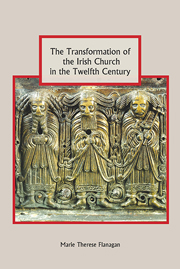Book contents
- Frontmatter
- Contents
- Acknowledgements
- Abbreviations and short titles
- Introduction
- 1 Charting change in the twelfth-century Irish church: the problem of sources
- Bishops and dioceses
- 2 ‘Regulating the dioceses of the bishops of Ireland’
- 3 ‘A mirror and model’: exemplary bishops and episcopal culture
- Varieties of monasticism
- Lay society
- Conclusion: Universal ideals and regional responses
- Bibliography
- Index
2 - ‘Regulating the dioceses of the bishops of Ireland’
from Bishops and dioceses
Published online by Cambridge University Press: 05 October 2013
- Frontmatter
- Contents
- Acknowledgements
- Abbreviations and short titles
- Introduction
- 1 Charting change in the twelfth-century Irish church: the problem of sources
- Bishops and dioceses
- 2 ‘Regulating the dioceses of the bishops of Ireland’
- 3 ‘A mirror and model’: exemplary bishops and episcopal culture
- Varieties of monasticism
- Lay society
- Conclusion: Universal ideals and regional responses
- Bibliography
- Index
Summary
A radical restructuring of episcopal jurisdiction is conventionally attributed to two landmark synods of the twelfth-century Irish church, the synod of Ráith Bressail (1111) and the synod of Kells (1152). According to the seventeenth-century historian Geoffrey Keating, who preserved in Irish translation a version of its acts, the synod of Ráith Bressail ‘regulated the faircheadha or dioceses of the bishops of Ireland’. It delimited territorially cohesive diocesan boundaries by naming four compass points, while within each diocese a specific church was designated as episcopal see. It also determined an archiepiscopal and primatial hierarchy: two archiepiscopal provinces with metropolitan sees located at Armagh and at Cashel were recognised, under each of which there were to be twelve episcopal sees, with primacy accorded to Armagh. A number of local assemblies, such as that held later in the same year at Uisnech in the provincial kingdom of Mide, subsequently altered the locations of sees but did not significantly modify the overall number.
The archiepiscopal provinces of Armagh and Cashel that had been agreed at Ráith Bressail were augmented in 1152 at the synod of Kells by the creation of the two additional archdioceses of Dublin and Tuam. Furthermore, that amended scheme was accorded formal papal approval by Cardinal John Paparo, who presided as papal legate and distributed pallia – symbols of a papally delegated metropolitan authority – for the four archbishops.
- Type
- Chapter
- Information
- Publisher: Boydell & BrewerPrint publication year: 2010



